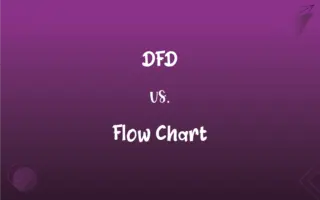Histogram vs. Bar Graph: What's the Difference?
Edited by Harlon Moss || By Janet White || Published on November 27, 2023
A histogram is a graphical representation of data distribution using contiguous bars, while a bar graph displays categorical data with separate bars.

Key Differences
Histograms are used to show the distribution of a numerical dataset, indicating the frequency of data within certain ranges. Bar graphs, in contrast, represent categorical data, with each bar representing a different category.
In a histogram, bars are adjacent, touching each other to indicate continuous data ranges. Meanwhile, in a bar graph, bars are separate, emphasizing the distinctiveness of each category.
Histograms often deal with large data sets and are useful in statistical analysis, showing trends over a range of values. While, bar graphs are more suited for comparing discrete quantities or categories, such as survey results.
The height of bars in a histogram reflects the frequency of data in each interval. However, in a bar graph, the height or length of each bar corresponds to the value or count of the category it represents.
Histograms are typically used for data like measurements or intervals, where the data falls into natural ranges. Whereas, bar graphs are used for data that can be divided into separate categories, like brands, types, or groups.
ADVERTISEMENT
Comparison Chart
Data Type
Numerical, showing distribution
Categorical
Bar Placement
Contiguous, bars touch each other
Separate, bars do not touch
Purpose
Shows frequency distribution
Compares different categories
Bar Height
Represents frequency in each range
Indicates value or count of a category
Common Use
Statistical analysis, data intervals
Discrete data comparison, surveys
ADVERTISEMENT
Histogram and Bar Graph Definitions
Histogram
Bars touch each other to indicate continuous intervals.
In the histogram, each bar represented a 10-point score interval.
Bar Graph
Bars are separated to emphasize different categories.
In the bar graph, each color represented a different product category.
Histogram
Used for continuous data to depict data ranges.
A histogram of temperatures showed the most common ranges during summer.
Bar Graph
Each bar’s height indicates the value or size of the category.
The bar graph clearly displayed the monthly rainfall in various cities.
Histogram
A graph showing frequency distribution in contiguous intervals.
The histogram displayed the age distribution of the survey participants.
Bar Graph
Often used in business and marketing for data comparison.
The bar graph was effective in showing the quarterly revenue of each department.
Histogram
Ideal for visualizing data spread and central tendency.
The histogram helped identify the average height in the population sample.
Bar Graph
A chart with bars representing different categories of data.
The bar graph compared sales across different regions.
Histogram
Often used in statistical analysis to reveal data patterns.
The histogram was used to analyze the frequency distribution of the exam scores.
Bar Graph
Useful for comparing discrete or categorical data.
The bar graph showed the favorite sports among students in the school.
Histogram
A bar graph of a frequency distribution in which one axis lists each unique value (or range of continuous values) in a set of data, and the area of each bar represents the frequency (or relative frequency) of that value (or range of continuous values).
Histogram
(statistics) A graphical display of numerical data in the form of upright bars, with the area of each bar representing frequency.
Histogram
(transitive) To represent (data) as a histogram.
Histogram
A bar chart representing a frequency distribution; heights of the bars represent observed frequencies
FAQs
Are the bars in a bar graph separated?
Yes, the bars in a bar graph are separated to distinguish different categories.
Can histograms be used for categorical data?
No, histograms are typically used for continuous numerical data.
Do bars touch in a histogram?
Yes, bars in a histogram touch each other to indicate continuous data.
Can a histogram show data trends?
Yes, histograms are good for showing data trends and distributions.
What kind of data is best for a bar graph?
Bar graphs are best for categorical or discrete data.
Is a bar graph useful for statistical analysis?
Bar graphs are more for comparison than deep statistical analysis.
What does the height of a bar represent in a histogram?
In a histogram, the height of a bar represents the frequency of data within an interval.
What does a bar graph show?
A bar graph shows comparisons among discrete categories.
What is a histogram used for?
A histogram is used to represent the frequency distribution of numerical data.
What does the height of a bar in a bar graph indicate?
The height of a bar in a bar graph indicates the value or count of that category.
Are bar graphs easy to read?
Yes, bar graphs are generally straightforward and easy to interpret.
How is data grouped in a histogram?
In histograms, data is grouped into continuous ranges or intervals.
Should histograms be used for ordinal data?
Histograms are not ideal for ordinal data; bar graphs are better suited.
Are histograms good for small data sets?
Histograms are better for larger data sets to show distribution patterns.
Do histograms require equal interval sizes?
Ideally, histograms should have equal interval sizes for accurate representation.
Can bar graphs show time series data?
Bar graphs can show time series data if it’s categorized discretely.
Can you compare two different variables with a bar graph?
Yes, bar graphs can compare different variables across categories.
Can you overlay multiple data sets in a histogram?
Overlapping multiple data sets in a histogram can be complex but possible.
Are colors important in bar graphs?
Colors can help distinguish different categories or variables in a bar graph.
Can a bar graph show proportional data?
Yes, bar graphs can display proportions within categories.
About Author
Written by
Janet WhiteJanet White has been an esteemed writer and blogger for Difference Wiki. Holding a Master's degree in Science and Medical Journalism from the prestigious Boston University, she has consistently demonstrated her expertise and passion for her field. When she's not immersed in her work, Janet relishes her time exercising, delving into a good book, and cherishing moments with friends and family.
Edited by
Harlon MossHarlon is a seasoned quality moderator and accomplished content writer for Difference Wiki. An alumnus of the prestigious University of California, he earned his degree in Computer Science. Leveraging his academic background, Harlon brings a meticulous and informed perspective to his work, ensuring content accuracy and excellence.

































































